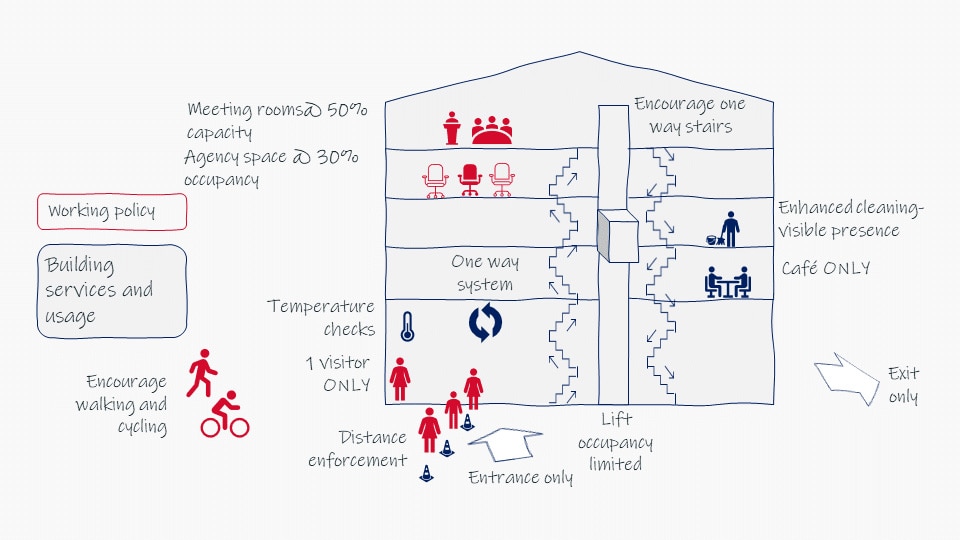After months of lockdown, organisations are now returning to the office. Getting Britain back to work safely will be critical over the coming weeks.
We have been helping many of our clients, as well as our own global group, plan their return to the ‘new normal’ – if that’s the right way to phrase it given we’re unlikely to see anything normal about the coming weeks or possibly months.
Nonetheless, we’re keen to do our part by making our learnings, tools and templates on how to plan for returning to work after the lockdown freely available. You can adapt, develop or implement them for your own organisation’s benefit. We hope you find them useful.
Before we start
Before we get into the detail, a few caveats to be aware of:
- The materials in this article have been developed for an office environment and are built around the UK Government’s guidelines for returning to offices. The materials can be adapted for other environments such as stores, factories and warehouses, but they will need some modification.
- If we have learnt anything over the last few weeks it’s that we need to be adaptable to a very fluid situation – and these recommendations are no exception. We expect to have to adapt the toolkit as government advice and the context in which we operate changes. Please check back periodically for any updates and the latest materials. Our assumptions for the toolkit based on the current government advice can be found here and will be updated as they change.
- Finally, the toolkit assumes that planning is led by a central planning group at the corporate or group level (this could be global if necessary) to co-ordinate the overall resumption of ‘normal’ and avoid reinventing the wheel. Planning needs to be done separately for every building, site and office and, although co-ordinated centrally, can be implemented locally by site and by department or group.
A phased return
In her article, ‘COVID-19: A roadmap to recovery and beyond’, Francesca Gualano outlines the four crisis response phases, culminating in recovery. We are about to enter the ‘resume’ phase. Planning for a phased return to the office ought to consider the needs of all the future stages. At a minimum, there should be an overarching framework that guides planning and against which assumptions can be tested. This is a very fluid scenario and it isn’t worth over-thinking, but some broad sweeping considerations will help provide anchor points, making it slightly easier to plan for returning to the office.
Planning framework
The planning framework is built around three streams: staffing considerations, building and services usage, and working policies.

These are broken down into detail in the return-to-work checklist, which can be appropriately adapted for your own use, but the broad questions to address are as follows.
Staffing considerations
- Gather information from staff to support returning to the office. Our employee questionnaire template is available here. If you have Office 365, it can be copied to use in your own environment.
- Who are the critical staff that need to be in the office?
- Which staff members are vulnerable if returning?
- How will you inform and train staff on new practices?
- How will you cover important volunteers like fire wardens and first aiders?
- How will they travel in and how will you support them?
- How will you assess and track staff risks?
- How will you communicate?
Use of buildings and services
- How does building/site usage have to change to make it safe?
- Have you conducted a risk assessment for each building? An example of a health and safety site analysis can be found here.
- How will common areas be accessed to comply with social distancing?
- Who are the critical building services teams?
- How will you train them and protect them?
- How will you scan (temperature check) entry into the building?
- How will you deal with and isolate anyone who fails a temperature check?
- What PPE is required to make the workplace safe?
- How will you engage and communicate with suppliers that also require building access?
Policies and central co-ordination
- How will you create or update policies for the current environment?
- Have you planned your PPE requirements and procurement?
- Have you designed and tested your return-to-office training?
- How will you track sickness and isolation (any new apps/systems)?
- Have you engaged insurance providers?
- Have you planned and designed appropriate signage?
- Have you conducted and reviewed your risk assessments?
All of these need to be considered in three distinct stage gates, so that there are very clear decision points around moving from one stage to the next.
Gate 1 – mobilise
Ensure you have established the right governance. It needs to be light touch to be nimble and fast, but comprehensive enough to make decisions on all aspects affecting returning to the office. Our sample governance framework that addresses this can be found here.
Gate 2 – approve returning to the office
This is essentially working through the three streams in detail, ensuring all aspects of returning to the office have been addressed, with all risk mitigations in place and a clear operational plan.
Gate 3 – go/no-go
The most important stage is ensuring that you are ready to allow staff back into the building. At this point, you need to be operationally ready, which includes doing a dry run of return to work. Staff need to feel protected and safe when they come back to the office and the best way to achieve this is for everything to run smoothly. It is far better to delay return to office by a week or two and make sure you get it right than to bumble through the first few days.
Moving forward
The work doesn’t stop once you are back in the office. There needs to be enough support to ensure the smooth running of the workplace. We suggest a period of hyper-care, with staff dedicated to supporting return-to-office workers and being available to respond to questions or queries. Equally important is to create a learning loop that includes both internal feedback from staff and external input from government guidelines.
All of this needs to be underpinned by great communication and having a well-thought-through communication plan. It would be a shame to put all this effort into planning and falling down at the communication hurdle. There are plenty of effective ways to communicate and we’ll be sharing some of these ideas in future updates.
If you have found this planning useful, we would be keen to hear from you. We would also be interested to hear about any improvements or modifications you’ve made to the templates. All organisations are currently facing similar return-to-work challenges. Anything we can do to share learnings and make it easier for each other can only help get us through this faster and onto the work we would all rather be doing.
We support organisations to adapt and respond to COVID-19 and beyond to ensure you are well-positioned to take advantage of new opportunities as we recover from the pandemic.


